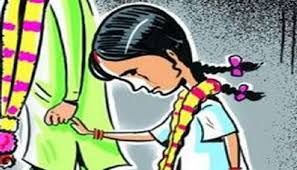Child Marriage Is A Curse
Jun 29, 2019 • 70 views
Child marriage has been one of the most awful and grievous custom being practiced at a very large scale in India, from a very long time with children married off before their physical and mental maturity. The problem of child marriage in India remains rooted in a complex matrix of religious traditions, social practices, economic factors and deeply rooted prejudices. Regardless of its roots, child marriage constitutes a gross violation of human rights, leaving physical, psychological and emotional scars for life.
There are approximately700 million women around the world today who were married as girls; a third of them were married before their 15th birthdays.
Forcing a young girl into marriage means separating her from her parents, home, friends, education etc and sending her to husband like a piece of property and indulging her more into household work who will be expected to bear children rather than play and study like the child she is.

Reasons which lead to Child marriage
Poverty, cultural norms, laws, illiteracy etc are some most common reasons which often leads to child marriage but it doesn't just stops there. Many countries have 18 as minimum marriageable age, but are forced to marry at younger age with parental consent.
India hasmore than 10 millionchild brides, the most of any country in the world, followed by Bangladesh, Nigeria, and Brazil.
In some cultures women are not seen as potential wage earners and are regarded as a burden for the family thus, Child marriage is the ultimate solution that their parents come up with. One less of a daughter to take care of means one less of a mouth to feed and one less of education to pay for. Girls are also married off to clear debts or settle any conflicts, effectively treating them as a substitute for money.

Money and poverty are not the only reasons for child marriage. In many cultures non-virgin girls are considered as impure and depraved for marriages so their families marry them off at a young age to ensure their daughters remains virgin and pious to marry and bear pure children.
Taking control over Child marriage
Child marriage is slowly becoming less practised around the world. Today,one in five girls are married as a child, as it was one in four in the 1980s.
The Child Marriage Restraint Act of 1929Edit
TheChild Marriage Restraint Act, also called the Sarda Act,was a law to restrict the practice ofchild marriage.Its goal was to eliminate the dangers placed on young girls who could not handle the stress of married life and avoid early deaths. This Act defined a male child as 21 years (originally 18) or younger, a female child as 18 years (originally 14) or younger, and a minor as a child of either sex 18 years or younger (originally 14).
The Prohibition of Child Marriage Act, 2006
The Government of India brought the Prohibition of Child Marriage Act (PCMA) in 2006, and it came into effect on 1 November 2007 to address and fix the shortcomings of theChild Marriage Restraint Act. The change in name was meant to prevent and prohibit child marriage, rather than to restrain it.
This Act kept the ages of adult males and females the same but made some significant changes to further protect the children.
•Boys and girls forced into child marriages as minors have the option of ending their marriage reaching adulthood up to two years.
• All money, gifts grants and valuable items should be returned if marriage is nullified and a place to live should be provided to the girl until she becomes an adult.
• A child born from the child marriage is considered to be legitimate, and the courts are expected to give parental custody with the children's best interests in mind.
• Any male who completes a child marriage or enters into a marriage with a minor. Any one who consducts or promotes a child marriage will be punished with upto two years of imprisonment or fine.
